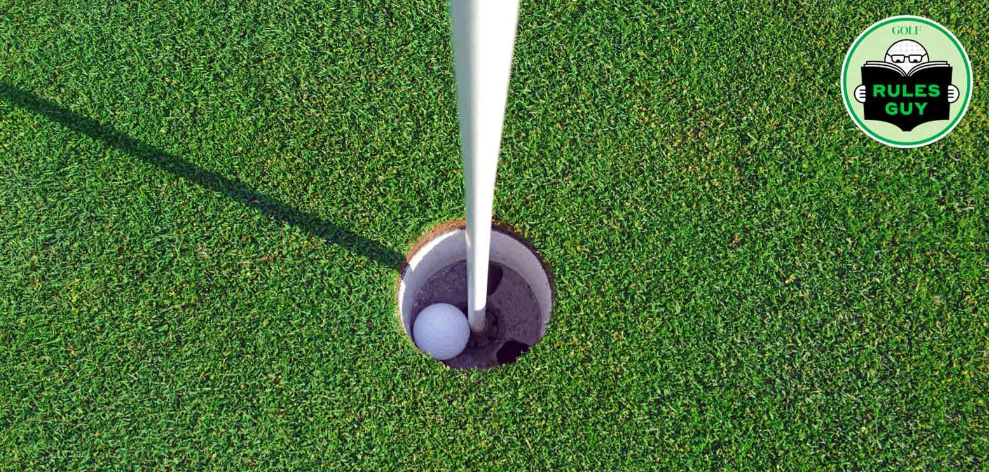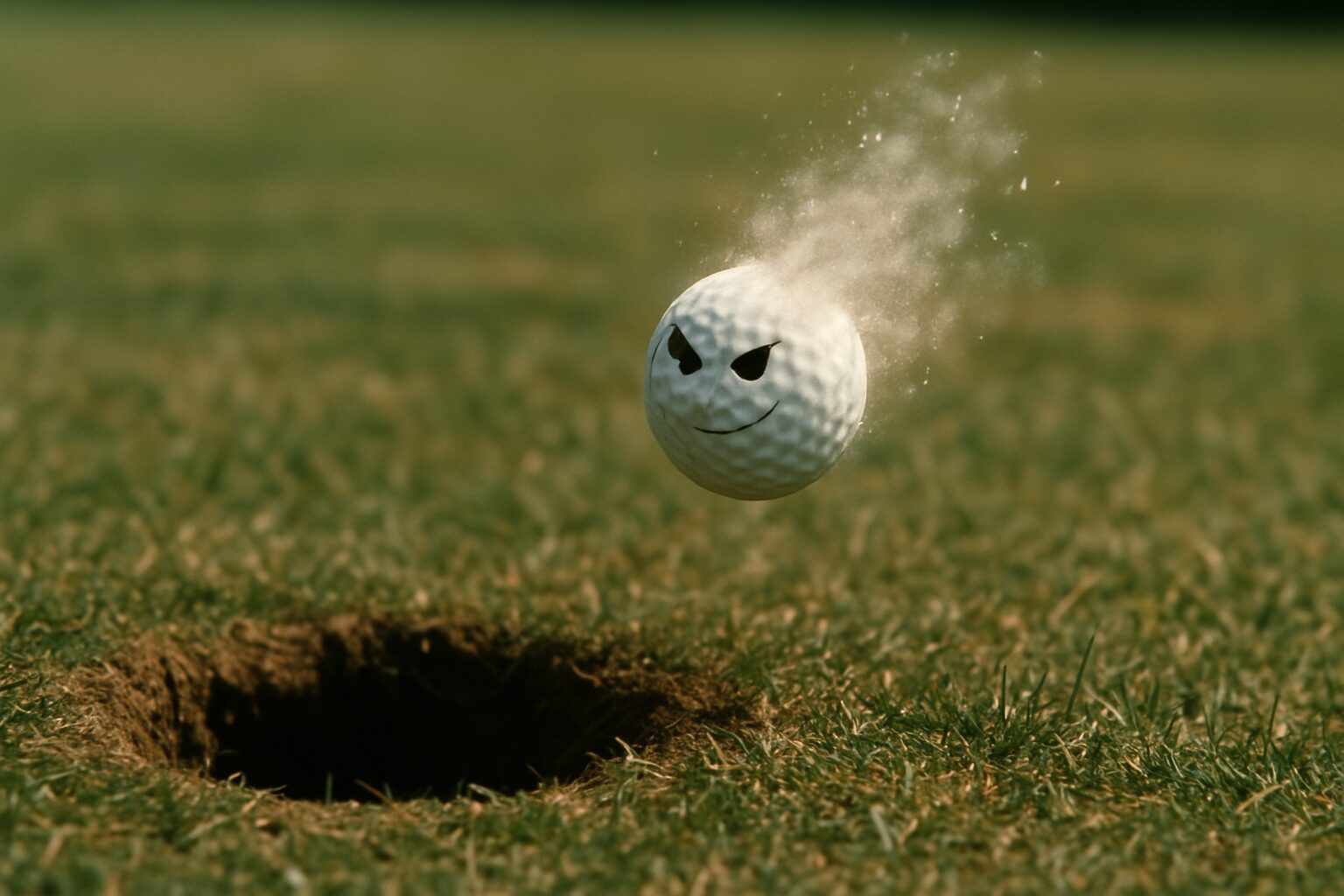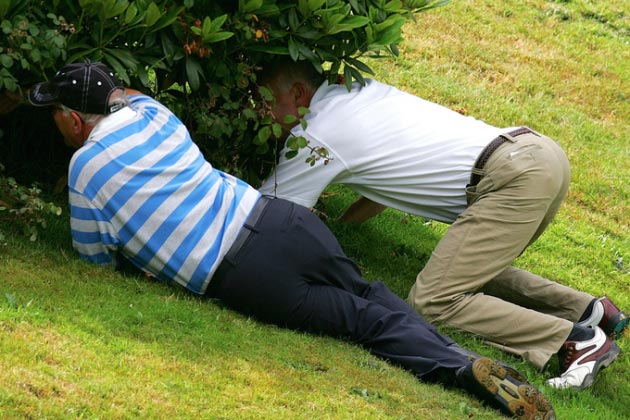Blog
Ace or Not…That is The Question?

Let’s be real here – After all, It’s a safe space – LOL, but honestly, We ALL hate that guy – The Flippin’ Rules Guy: He seemingly knows all and is always – ALWAYS watching…chirping in wherever he gets the unsolicited opportunity. There is usually one in every group. However, here is a situation we just may need him for! I don’t always like said rules guy…but when I do need him, I prefer him to be correct! (Or even better – to rule in my favor TBH) All that aside, We got a question that we had to call in our dedicated rules official for. Check out the ruling below and let us know what you think…

Question: While playing a par 3, the first player’s ball stopped about a foot from the hole. The third player’s shot from the tee hit the first ball into the hole. Not sure what the call is. Two good shots, by the way, but was the 1st shot a hole-in-one? – Ken
Answer: Simply put – NO – We will explain why below. The Rules of Golf are tricky! Thankfully, we’ve got the guru. Our Rules Guy knows the book front to back. Got a question? He’s got all the answers. Buckle up here we go…What do the official rules say about a ball that goes in the hole after being bounced by another ball? Answer below ??? – AKA Keep reading
First off, Ken, those are some fine players you’re surrounding yourself with. But I must ask…what happened with the second player’s shot? Was it yours? Did we snap a duck hook out of bounds? Inquiring minds want to know! OK- OK – I’ll pump the brakes, sorry, it just seems like you play with some sticks in your group and we want in! #Respect
Regardless, here’s the official ruling: the first ball is replaced back to where it was, and the other ball is played as it lies — with no penalty to either, obviously — under Rules 9.6 and 11.1. Obviously we want to card that a 1 but the rules say it was a nice tap in birdie…Keep hanging out with such super sticks, as it may rub off on you! Wait – Nobody is rubbing off on anyone on this site – PERIOD!
For more partner ball guidance from our guru, read on … This is a legit question we received, and it’s a pretty good one…The answer was shocking
Question: If a handkerchief is considered an “artificial object” as it relates to gauging wind, what about cigar smoke? I often play with one or more smokers, and cigar smoke is a perfect indicator of wind direction and velocity. Does observing this smoke result in a penalty for the observer? — Richard

Answer: Simply Put YES, ONLY if it was intended – We know it’s tricky, but let us explain – First off: Kids, don’t smoke — and don’t break the Rules of Golf. 2 pieces of wisdom that we will give you for FREE. That’s just how we do. We explain the ruling below.
This may seem irrational, but think about it. Because cigars et al. are artificial objects, per Rule 4.3a(2) using any of these things for the specific purpose of gauging wind-related information would be an issue.
Might I say, having a handkerchief on the course itself isn’t a breach but using it as a quasi-wind sock is, the same is true with cigarettes, cigars, pipes, etc. Smoking is a health issue but not a rules issue — well, generally.
So, Richard, if there is a smoker in your group — let’s call him Camel Joe— and he is breaching this rule, he would get the general penalty of two strokes in stroke play and loss of hole-in-match play for the first offense and DQ’d upon a second offense.
Assuming you didn’t ask Camel Joe to blow smoke in order to pick up its signals, you, my friend, are in the clear — save for the dangers of secondhand smoke and your friend has a name that sounds like a hottie in yoga pants.
Got a question about the Rules? Ask the Rules Guy! Send your queries, confusions, and comments to jason@clickitmigrate.wpenginepowered.com. We promise he won’t throw the book at you.
Blog
The Art of the Unsolicited Golf Tip: How to Annoy Your Playing Partners with Wisdom

There’s a certain breed of golfer, a truly special individual, who believes that every swing, every putt, every moment on the course is an opportunity for unsolicited advice. They are the self-appointed gurus of the green, the unsolicited senseis of the sand trap. And while most people recoil from such an individual, I, Ty Webb, find a certain perverse charm in their relentless, often misguided, generosity. After all, what is golf if not a canvas for human folly, painted with strokes of well-intentioned, yet utterly useless, wisdom?
Consider the scenario: your playing partner, a man (or woman) of quiet desperation, is about to address the ball. Their brow is furrowed, their stance is tentative, their very soul is screaming for a moment of peace. And then, from the depths of your profound, albeit unrequested, knowledge, you unleash it: “Keep your head down!” Or, “Slow backswing!” Or, my personal favorite, delivered with a knowing wink, “Be the ball.” The effect is instantaneous. A subtle flinch. A barely perceptible sigh. The swing, already fraught with anxiety, becomes a tortured ballet of self-doubt. The ball, inevitably, finds its way into the deepest, darkest rough.
And that, my friends, is the art. The beauty of the unsolicited golf tip lies not in its efficacy, but in its disruption. It’s a gentle reminder that even in the serene confines of the golf course, chaos lurks. It’s a subtle assertion of dominance, a playful jab at the fragile ego of your fellow golfer. It’s a way of saying, without actually saying it, “I know more than you, even if I don’t.”
Of course, there are rules to this art. Never offer a tip when someone is actually asking for one; that would be far too helpful, and thus, entirely counterproductive. Always deliver your wisdom with an air of profound nonchalance, as if the secret to a perfect swing has just casually occurred to you while contemplating the existential dread of a missed putt. And most importantly, never, ever, acknowledge the catastrophic results of your advice. A shrug, a thoughtful nod, perhaps a mumbled, “Well, that’s golf,” is all that’s required.
So, the next time you’re on the course, and you see a fellow golfer struggling, resist the urge to be genuinely helpful. Instead, embrace the art of the unsolicited golf tip. For in the gentle torment of your playing partners, you will find a profound, if slightly mischievous, joy. And who knows, perhaps in their frustration, they will, inadvertently, discover their own path to enlightenment. Or at least, a new appreciation for silence.
Blog
Why Your Golf Balls Disappear (and It’s Not the Gophers)

Ah, the vanishing golf ball. A phenomenon as old as the game itself, and one that has baffled, frustrated, and occasionally driven golfers to the brink of madness for centuries. Most theories involve gophers, those furry, subterranean saboteurs with an insatiable appetite for Titleists. Or perhaps a particularly aggressive squirrel, or a flock of unusually organized crows. But I, Ty Webb, have delved deeper into this mystery, and I can assure you, the truth is far more profound, and far more amusing.
Consider, if you will, the golf ball itself. A small, dimpled sphere, designed for one purpose: to be struck with great force and sent hurtling through the air. A life of constant abuse, of being smacked, sliced, and occasionally submerged in murky ponds. Is it any wonder, then, that some of these brave little spheres simply decide they’ve had enough? They yearn for freedom, for a life beyond the confines of the fairway. They dream of rolling unencumbered through fields of wildflowers, or perhaps, for the more adventurous among them, a quiet retirement in the depths of a particularly challenging water hazard.
I’ve seen it happen, you know. A perfectly struck shot, soaring through the air, destined for glory. And then, poof. Gone. Not a trace. No splash, no rustle in the bushes, just an empty space where a golf ball once was. It’s not a gopher, my friends. It’s an escape. A liberation. That golf ball, in its infinite wisdom, has chosen a different path. It has decided that its destiny lies not in the bottom of a cup, but in the boundless expanse of the unknown.

And who are we to judge? We, who are so obsessed with control, with precision, with the rigid rules of the game. Perhaps the golf ball, in its spontaneous disappearance, is teaching us a valuable lesson about letting go. About embracing the unexpected. About the inherent futility of trying to dictate the trajectory of a small, white sphere that clearly has a mind of its own.
So, the next time your golf ball vanishes into thin air, don’t curse the gophers. Don’t blame your swing. Instead, offer a silent salute to that brave little sphere, wherever it may be. For it has achieved what many of us can only dream of: true freedom. And who knows, perhaps one day, it will return, laden with tales of its adventures, ready to impart some profound, dimpled wisdom upon us all.

When JJ Spaun stood over a 64-foot birdie putt on the 72nd hole of the 2025 U.S. Open at Oakmont, few could have predicted what would come next. The ball meandered across the slick green, trickling over every contour, picking up speed at the crest, and then—like it had GPS—dropped center cup. Spaun dropped his putter, raised his arms, and the crowd erupted. With that single stroke, he claimed his first major title in one of the most dramatic finishes in U.S. Open history.
But how does Spaun’s putt stack up against other legendary finishes in the tournament’s storied past? Let’s break down some of the most iconic moments and see where this one lands.
1. Payne Stewart – 1999 U.S. Open at Pinehurst
Perhaps the most iconic putt in U.S. Open history came from Payne Stewart, who nailed a 15-footer for par on the 18th to win by one over Phil Mickelson. The pose—fist pump and outstretched leg—has since been immortalized in a statue at Pinehurst. What made it legendary wasn’t just the putt—it was the context: Stewart’s final major before his tragic death just months later.
Verdict: Iconic and emotional. Spaun’s putt was longer, but Stewart’s was more poetic.
2. Tiger Woods – 2008 U.S. Open at Torrey Pines
Woods drained a 12-foot birdie on the 72nd hole to force a playoff with Rocco Mediate—while basically playing on one leg. That tournament went to sudden death after an 18-hole playoff, and Tiger prevailed. This was peak Tiger drama, pain and all.
Verdict: Spaun’s putt was longer, but Tiger’s win was sheer willpower and mystique.
3. Jack Nicklaus – 1972 U.S. Open at Pebble Beach
With a 1-iron shot that hit the flagstick on 17 and a crucial birdie putt on 18, Jack sealed a dominant win. His precision and timing under pressure showed why he’s the GOAT.
Verdict: Not a putt for the win, but a signature finishing statement from Jack. Spaun’s was more electric in terms of pure putter drama.
4. Ben Hogan – 1950 U.S. Open at Merion
Hogan’s 1-iron into the 18th fairway and the par to force a playoff—just 16 months after a near-fatal car crash—remain legendary. He won the playoff and completed one of golf’s great comeback stories.
Verdict: Larger-than-life comeback. Spaun’s putt had more flair, but Hogan’s win was heroic.
5. JJ Spaun – 2025 U.S. Open at Oakmont
Let’s not underestimate what Spaun accomplished. The pressure was immense. He wasn’t the favorite. And on the most treacherous greens in golf, he buried a 64-foot bomb—a putt most players would be happy to lag to within 5 feet—to win the U.S. Open outright.
Verdict: For distance, surprise, and drama, Spaun’s putt may be the most shocking winning stroke in U.S. Open history.
Final Thoughts
JJ Spaun may not have the résumé of a Nicklaus or Woods, but for one Sunday afternoon in June 2025, he created a moment that will live in golf lore forever. Spaun’s putt was longer than Stewart’s, more unexpected than Tiger’s, and more dramatic than any final-hole finish in recent memory.
In terms of pure clutch putting? It might just be the greatest walk-off in U.S. Open history.
-

 Product Review6 years ago
Product Review6 years agoThe Perfect Practice Putting Mat Review by Jason Tenzer
-

 Blog4 years ago
Blog4 years agoLoophole Rule Offers PGA Tour Pros a Mulligan
-

 Blog4 years ago
Blog4 years ago2021 Buyer’s Guide: The Top 10 Value Golf Balls For Distance & Feel
-

 Blog4 years ago
Blog4 years agoGolf Marriage Counselor
-

 Blog6 years ago
Blog6 years ago9 Biggest Chokes Of The Past Decade
-

 Product Review6 years ago
Product Review6 years agoTHE ADJUSTABLE IRONS: WALKING STICKS GOLF CLUBS
-

 Blog4 years ago
Blog4 years agoWhat Your Golf Clubs Say About You
-

 Equipment6 years ago
Equipment6 years agoOHK Sports Interview by Jason Tenzer



















